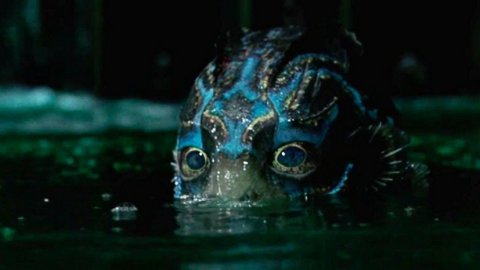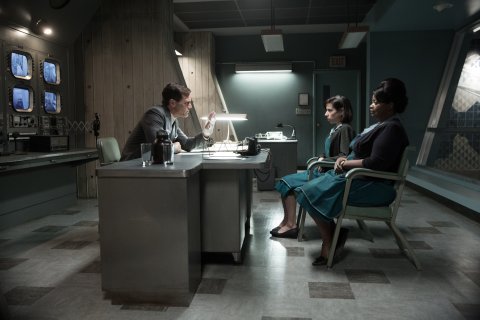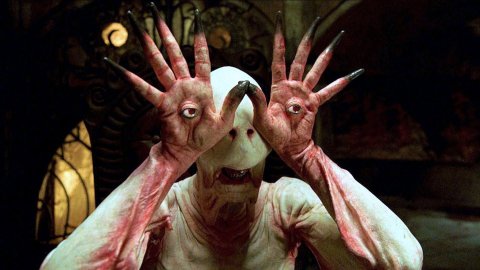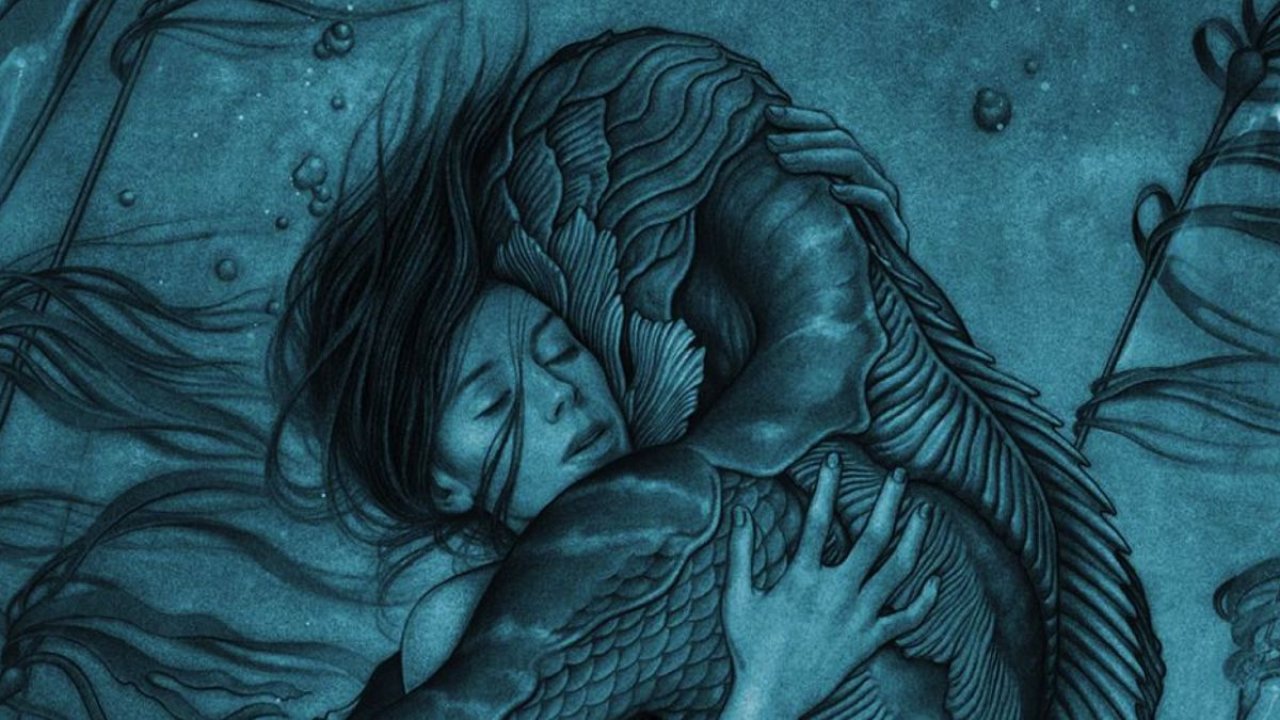In the first few minutes of Guillermo del Toro's The Shape of Water, a mute janitor named Elisa, played by Sally Hawkins, draws herself a bath and masturbates. She completes this quick ritual several times early in the film as part of her daily routine. Elisa is lonely, and efficient.
Eventually, she meets the man—or, rather, the monster—of her dreams: an aquatic humanoid without a name, played by Doug Jones under layers of hand-painted latex. Del Toro is a noted monster visionary (as in, an inventor of creatures), but this is the first time the director has envisioned one that makes love to a woman.

The story, written by del Toro and Vanessa Taylor, takes place in 1962, in a repressed, Cold War-era Baltimore. Elisa works on the night shift at Occam Aerospace Research Center, where an American colonel, Richard Strickland (Michael Shannon), has captured and imprisoned the Amphibian Man to be harvested for research. The film is filled with fantastical and challenging sexual images. The abusive Strickland demands complete silence from his wife as they have unpleasant missionary sex. Elisa's neighbor, a gay painter (Richard Jenkins), pines for a local waiter who angrily rejects him. And Elisa's friend (Octavia Spencer) complains about the emotional distance growing between her and her husband. Everyone is unhappy, and no one knows why.
And yet, del Toro insists, The Shape of Water is his most optimistic movie. The Mexican-American auteur behind Pacific Rim and Hellboy says, "Every other film I've done, even the big ones, have a sense of loss about them. A film about love, empathy, sex, and politics…it's a risk for me."
"But I feel safe watching it," he adds, "like there are possibilities hanging there. It's not a melancholic beauty, it's almost a healing force."

As with Pan's Labyrinth, the director's sumptuous 2006 fantasy, viewers are asked to suspend disbelief. Days after discovering Amphibian Man in his locked tank, Elisa begins flirting with him. The not-entirely-human creature, with the sexy swimmer's body, looks longingly at Elisa, through gold-flecked, wide eyes that move in a reptilian way. "He's not an animal, he's an elemental river god," says del Toro, who was inspired by Japanese drawings of fish rather than biology. "He needed to have a kissable face."
Del Toro wrote the part of Elisa for Hawkins. The British actress—a sometime muse for director Mike Leigh—is best known in the U.S. for her Oscar-nominated work in Woody Allen's Blue Jasmine. "The real miracle of the Amphibian Man is the way Sally looks at him," says del Toro. "Her eyes vibrate with emotion. All the characters in the film who have the ability to speak have communication problems, but our two nonverbal characters communicate flawlessly."

At one point in the film, the mute Elisa signs, "When he looks at me, the way he looks at me, he never knows I'm incomplete." Del Toro considers that "the best definition of love I've found in my 53 years."
Through painterly visual cues and colors, the characters are further revealed. Strickland's suburban home is so brightly lit, it feels oppressive. Elisa's apartment has an aquatic palette, reflecting her desire to be underwater. Once she and the creature consummate their relationship, she begins to wear red, a color that, to del Toro, represents "the cinema and love."
The Shape of Water includes a subplot that follows Russian spies in the United States, but the story is clearly an allegory about contemporary America. "I never make escapist fantasies," del Toro says. "And the best way to tell a story about our current lives is to find a parallel in the past."
The year 1962, he explains, is remembered in the U.S. as the end of a fairy tale. John F. Kennedy, who turned the presidency into a 20th-century Camelot, would be assassinated the next year. Behind the post-World War II affluence—two cars in the garage, a TV in every living room, smiling families with ample leisure time—things were falling apart. "It was a divisive time for anyone who was not the right gender or the right race," del Toro says. "For many, it was a period of riots and unrest."

The real monster, of course, is Strickland—a willfully ignorant isolationist, the classic ugly American. When Elisa brings the creature home, hiding him in her bathtub, a raging Strickland goes to brutal lengths to get him back.
Del Toro was born in Mexico, where, thanks to the Spanish conquerors, paganism and pre-Colombian beliefs are forever fused with Catholicism. A similar syncretism happened as he grew up in Guadalajara, looking at Catholic imagery of saints while watching classic horror movies. Saints and Christ are often depicted with "near forensic accuracy," del Toro says, "their great power forcibly crushed when they are tortured or made 'other' while on earth. I'm not being facetious or trying to be clever," he adds, "but I saw a martyr in Boris Karloff when he crossed the threshold as Frankenstein. [Monsters and saints] are linked now in my mind, both representing truths and spiritual dimensions."

The Shape of Water is not, to del Toro's mind, a horror film, a categorization of his work he has disputed before. "People say I'm a genre filmmaker, and I say yes, my own genre. I'm not interested in working in a single lane. I'll write a fairy tale in a fascist postwar space or a ghost story in Civil War Spain (The Devil's Backbone) or a story about a vampire in middle-class Mexico (Cronos). The sci-fi and fantasy novelist Theodore Sturgeon said 90 percent of everything science fiction is crud because 90 percent of everything is crud. That's Sturgeon's law. Well, del Toro's law is that 10 percent of everything is great."
He's also not interested in classic film scare tactics; the horror he's addressing is far more insidious. "What scares me as an adult man is the way ideology can divide us," del Toro says. "When you reduce a person to a single word, that makes it easier to hurt them or ignore them. We are polychrome beings, not just one thing. Whether it's an immigration thing, or a gender thing, or just a power thing…hate can only breed without understanding."
The optimism of this latest project has inspired del Toro to take a year off. He wants to catch up on novels he missed in 2018 and "watch sunsets." On the other hand, he's also co-writing a book with Chuck Hogan and producing three series for Netflix. How does that translate into a break? Del Toro laughs. As he explains it, juggling just four projects is a reprieve. "After you hit 40, you start crafting your biography and epitaph in your head, and my epitaph is in great danger," he says. "One day, it will read, 'Here lies Guillermo del Toro, who lived and loved and filmed a few things.' I've filmed a few things, you know? Now I need to live."
















